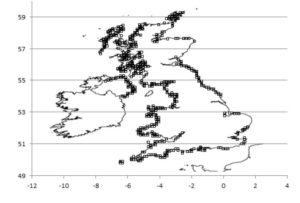Broadscale intertidal biodiversity: patterns from compiled datasets and spatial relationships with consumer trophic structure
1) How do important intertidal consumers, such as limpets, snails and mussels, adjust their diet breadth across locations of different seaweed diversity?
 This is important because these abundant organisms control the base of the food web, affecting abundances of other organisms and are themselves consumed by ‘higher’ consumers, such as fish and birds. I asked this in two biogeographic regions; Northwest Europe, and the Southeast Pacific (represented by Northern Ireland and Northern Chile, respectively), sampled using a spatially nested design, alike that of CBESS. Consumers were anticipated to either specialise or generalise their resource use depending on seaweed diversity or, alternatively, environmental features were anticipated to dominate resource contributions. In both regions, environmental factors controlled both consumer resource use and seaweed diversity. In Northern Ireland this took the form of a gradient from sheltered, enclosed loughs to coastline exposed to the open Atlantic Ocean. In Northern Chile this took the form of intensity of upwelling of deep, nutrient-rich water, with high intensities frequently found at exposed headlands, whilst sheltered bays retain coastal water. These results provide a potential back-drop for CBESS results looking at the food web, allowing prediction of the the broad-scale context of resource use.
This is important because these abundant organisms control the base of the food web, affecting abundances of other organisms and are themselves consumed by ‘higher’ consumers, such as fish and birds. I asked this in two biogeographic regions; Northwest Europe, and the Southeast Pacific (represented by Northern Ireland and Northern Chile, respectively), sampled using a spatially nested design, alike that of CBESS. Consumers were anticipated to either specialise or generalise their resource use depending on seaweed diversity or, alternatively, environmental features were anticipated to dominate resource contributions. In both regions, environmental factors controlled both consumer resource use and seaweed diversity. In Northern Ireland this took the form of a gradient from sheltered, enclosed loughs to coastline exposed to the open Atlantic Ocean. In Northern Chile this took the form of intensity of upwelling of deep, nutrient-rich water, with high intensities frequently found at exposed headlands, whilst sheltered bays retain coastal water. These results provide a potential back-drop for CBESS results looking at the food web, allowing prediction of the the broad-scale context of resource use.
2) How well do different components of intertidal biodiversity relate to each other (e.g. rare seaweeds with rare molluscs), and to what extent are these relationships controlled by important environmental factors (e.g. wave exposure, species interactions)?
 We value rare species for different reasons than common species, although many arguments can be put forward to the conservation of either. First, however, we must understand how these different components interrelate to see if conserving one will let us also conserve another. To ask this question I used freely available data and developed quality control measures (for sampling effort) to enable a UK-wide study of seaweed, molluscs and crustaceans; the dominant organisms (taxa) of most intertidal habitats. Pilot studies in Northern Ireland suggested that cleverer statistical designs were necessary to ask these questions. Across the UK, common species of all taxa were stronger related than the total diversity of all taxa, to each other. Furthermore, rare species were also moderately related in certain cases, overall suggesting that conserving certain groups may conserve others (a sort of ‘buy-one-get-one-free’ effect). To fully understand these relationships, ongoing research investigates the significance of environmental factors (including sampling effort) for these different groups. These results, having UK-wide relevance, allow the CBESS Morecambe Bay and the Essex marshes, with their sub-sites, to be observed in wider context, for instance comparatively with their neighbouring coastlines.
We value rare species for different reasons than common species, although many arguments can be put forward to the conservation of either. First, however, we must understand how these different components interrelate to see if conserving one will let us also conserve another. To ask this question I used freely available data and developed quality control measures (for sampling effort) to enable a UK-wide study of seaweed, molluscs and crustaceans; the dominant organisms (taxa) of most intertidal habitats. Pilot studies in Northern Ireland suggested that cleverer statistical designs were necessary to ask these questions. Across the UK, common species of all taxa were stronger related than the total diversity of all taxa, to each other. Furthermore, rare species were also moderately related in certain cases, overall suggesting that conserving certain groups may conserve others (a sort of ‘buy-one-get-one-free’ effect). To fully understand these relationships, ongoing research investigates the significance of environmental factors (including sampling effort) for these different groups. These results, having UK-wide relevance, allow the CBESS Morecambe Bay and the Essex marshes, with their sub-sites, to be observed in wider context, for instance comparatively with their neighbouring coastlines.
